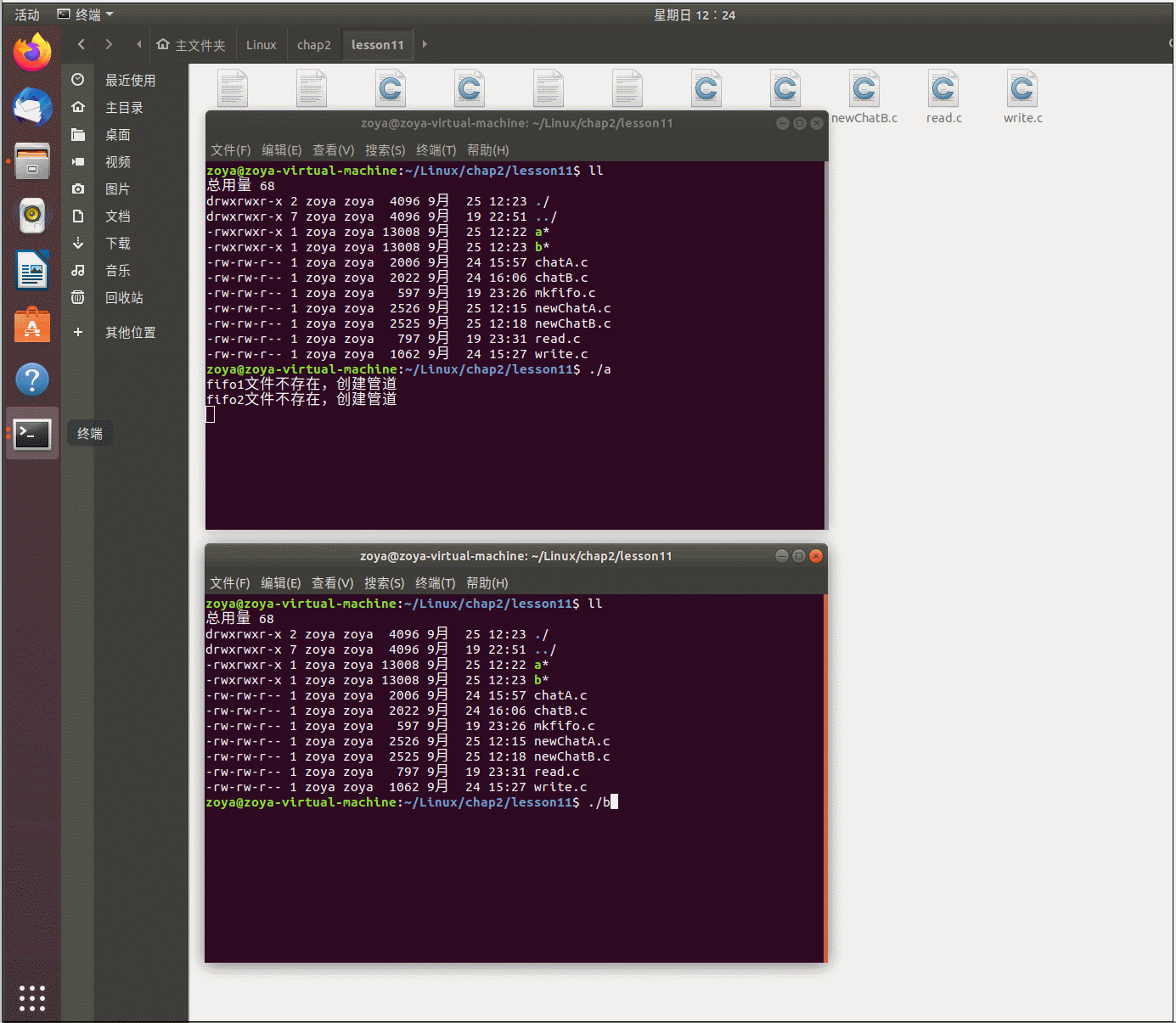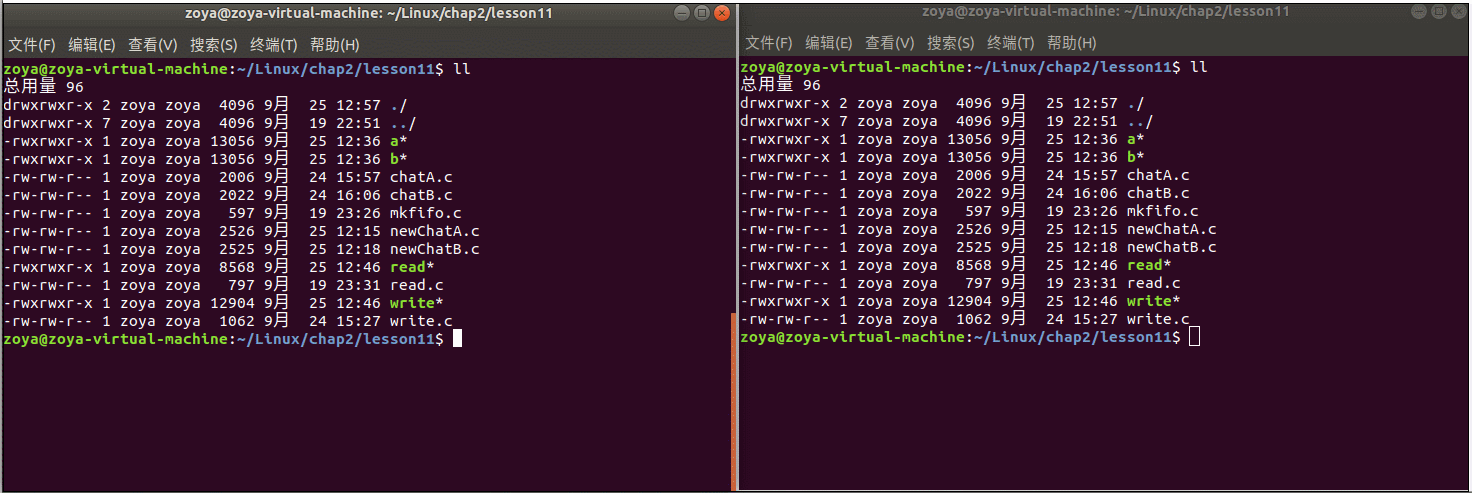【Linux】Linux进程间通信——有名管道
文章目录
- 进程间通信之有名管道
-
- 一, 有名管道简介
- 二, 有名管道的使用
-
- 1. 创建有名管道
- 2. 有名管道的注意事项
- 三, 有名管道简单实例
进程间通信之有名管道
进程间通信有多种方式实现,本文主要讲解有名管道的通信方式。
一, 有名管道简介
匿名管道由于没有名字,只能用于具有亲缘关系的进程间通信。
为了克服这个缺点,就提出了有名管道(FIFO),也称为命名管道、FIFO文件。
有名管道(FIFO)提供了一个路径名与之关联,以FIFO的文件形式存在于文件系统中,且打开方式与打开一个普通文件是一样的。即使与FIFO的创建进程不存在亲缘关系的进程,只要可以访问该路径,就能够彼此通过FIFO相互通信。因此,通过FIFO不相关的进程也能交换数据。
FIFO文件被打开,就可以使用与操作匿名管道和其它文件的系统调用一样的I/O系统调用,如使用 read()读数据,write()写数据,close()关闭FIFO等。
与匿名管道一样,FIFO也有一个写入端和读取端,且从管道中读取数据的顺序与写入数据的顺序是一样的。FIFO的名称也由此而来:先入先出,也是一个环形队列。
有名管道和匿名管道大部分是相同的,不同在于:
- FIFO在文件系统中作为一个特殊文件存在,FIFO的内容存放在内存中;
- 当使用FIFO的进程退出后,FIFO文件将继续保存在文件系统中以便以后使用;
二, 有名管道的使用
1. 创建有名管道
- 方式1:可以使用命令创建有名管道:
$ mkfifo 名字
- 方式2:使用函数
mkfifo()函数创建有名管道
使用mkfifo()创建了FIFO后,就可以使用open()打开它,常见的文件I/O函数都可以用于FIFO。
FIFO严格遵循先进先出,对FIFO的读总是从开始处返回数据,对FIFO的写则是把数据添加到末尾,FIFO不支持lseek()等文件定位的函数。
函数mkkfifo()声明:
#include - 参数说明:
- pathname:管道名称的路径;
- mode:FIFO的权限,和open是一样的;如0664;
- 返回值:成功返回0,失败返回-1,并设置对应的errno;
创建管道示例:
#include 有名管道使用示例,有两个文件,read.c用来读管道中的数据,write.c用来向管道写数据。read.c和write.c的内容如下:
read.c
// 从管道中读取数据
#include write.c:
// 向管道中写数据
#include 生成可执行文件 read 和 write,当只执行read或只执行write时,会一直阻塞;当两个文件都执行时,会进行数据传递;
2. 有名管道的注意事项
- 一个进程以只读打开管道会阻塞,直到另外一个进程以只写打开管道;
- 一个进程以只写打开管道会阻塞,直到另外一个进程以只读打开管道;
有名管道的读写特性:
- 读管道
- 管道中有数据,read返回实际读到的字节数;
- 管道中无数据:
- 管道写端被全部关闭,read返回0,相当于读到文件末尾;
- 管道写端没有被全部关闭,read阻塞等待;
- 写管道
- 管道读端全部关闭,进程异常终止,收到信号SIGPIPE;
- 管道读端没有被全部关闭:
- 管道已经满了,write阻塞等待
- 管道没有满,write将数据写入,并返回实际写入的字节数
三, 有名管道简单实例
- 使用有名管道完成简单聊天的功能
进程A
- 以只写方式打开管道1;
- 以只读方式打开管道2;
- 循环写读数据;
进程B
- 以只读方式打开管道1;
- 以只写方式打开管道2;
- 循环读写数据;
代码:
chatA.c
#include chatB.c
#include 执行生成的可执行文件a、b:

可以看出来上面的程序还是有点问题,两个进程之间只能"你来我往"——a发送一句,b接收一句,然后b再发送,a再接收...,不能a或b连续发送几句,a或b一直接收。
解决方案:读写操作分别放到不同的进程中,比如a中父进程写FIFO1,子进程读FIFO2,b中父进程写FIFO2,子进程读FIFO1。
实现参考:
newChatA.c
#include newChatB.c
#include 
